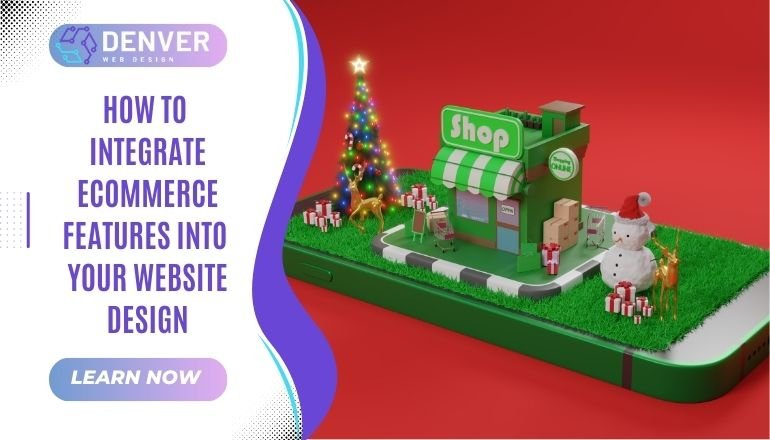
In today’s digital landscape, integrating e-commerce features into your website design is essential for businesses looking to expand their reach and drive sales. A well-designed e-commerce website provides a seamless user experience, increases customer trust, and supports business growth. By incorporating best practices in web design and development, you can create a site that not only attracts users but also converts them into loyal customers. For businesses in Denver, working with experts like Web Design Denver can ensure your website meets these needs effectively and efficiently.
What is E-commerce Integration?
E-commerce integration involves incorporating online shopping features into your website, allowing customers to browse products, add items to their carts, and complete transactions without leaving your platform. This process includes setting up secure payment gateways, creating detailed product pages, and ensuring a smooth checkout process. Related principles, such as responsive web design and mobile-first approaches, are critical to ensuring accessibility and usability for all users, regardless of the device they use.
Why is E-commerce Integration Essential for Your Website?
E-commerce integration is vital for businesses aiming to remain competitive in the digital era. Here’s why:
- Improves Customer Experience: Features like intuitive navigation, quick-loading pages, and clear CTAs enhance user satisfaction.
- Boosts Revenue: By offering a seamless purchasing experience, you can drive more conversions and increase average order value.
- Expands Market Reach: An e-commerce-enabled website allows you to sell to customers beyond your local area.
- Enhances SEO: E-commerce websites with optimized product descriptions, images, and metadata rank better on search engines.
A professionally designed website by Web Design Denver can ensure your e-commerce site is both functional and attractive, helping you maximize these benefits.
Key Features of E-commerce Website Design
When integrating e-commerce features into your site, these components are crucial:
- Secure Payment Gateways – Provide customers with trusted options like PayPal, Stripe, or credit card payments.
- Product Listings – Create comprehensive and visually appealing product pages with high-quality images, detailed descriptions, and user reviews.
- Intuitive Navigation – Ensure users can quickly find products and categories with a logical site structure.
- Responsive Design – Optimize for all devices to guarantee a smooth shopping experience on desktops, tablets, and smartphones.
- Shopping Cart and Checkout Process – Simplify the buying process with features like guest checkout, multiple payment options, and order confirmation emails.
- Search Functionality – Help users find specific items with advanced search and filter options.
- Customer Support Options – Integrate live chat, email, or phone support to assist users instantly.
Best Practices for E-commerce Integration
To ensure the success of your e-commerce website, follow these best practices:
- Optimize Site Speed: Use lightweight images, implement caching, and choose a reliable hosting service.
- Focus on UX Design: Prioritize user-friendly navigation and accessibility.
- Leverage Analytics: Use tools like Google Analytics to track user behavior and refine your website.
- Adopt a Mobile-First Approach: Design your site for mobile users, ensuring responsiveness and usability.
- Test Functionality: Regularly test your website’s features, including payment systems, navigation, and search filters.
- Incorporate SEO Elements: Optimize product descriptions and ensure your site’s metadata adheres to SEO best practices.
Common Mistakes to Avoid in E-commerce Web Design
Avoid these pitfalls to ensure your e-commerce website performs effectively:
- Overcomplicated Navigation: If users struggle to find what they’re looking for, they’ll leave your site.
- Neglecting Mobile Optimization: Ensure your site is mobile-friendly to cater to today’s users.
- Slow Load Times: Pages that take too long to load frustrate customers and increase bounce rates.
- Unclear Shipping Information: Provide detailed shipping options and costs upfront to build trust.
- Poor Product Descriptions: Vague or unhelpful descriptions fail to provide the information buyers need.
By addressing these issues, businesses can create a website that is functional, appealing, and optimized for conversions.
Conclusion: Key Takeaways
Integrating e-commerce features into your website design is crucial for enhancing user experience, expanding market reach, and boosting business growth. By focusing on responsive design, intuitive navigation, and essential features like secure payment gateways, you can create an online store that meets the needs of your audience. For tailored solutions, partnering with a professional service like Web Design Denver ensures your website stands out and delivers measurable results. Start optimizing your website today to create a seamless shopping experience and unlock the full potential of e-commerce.






